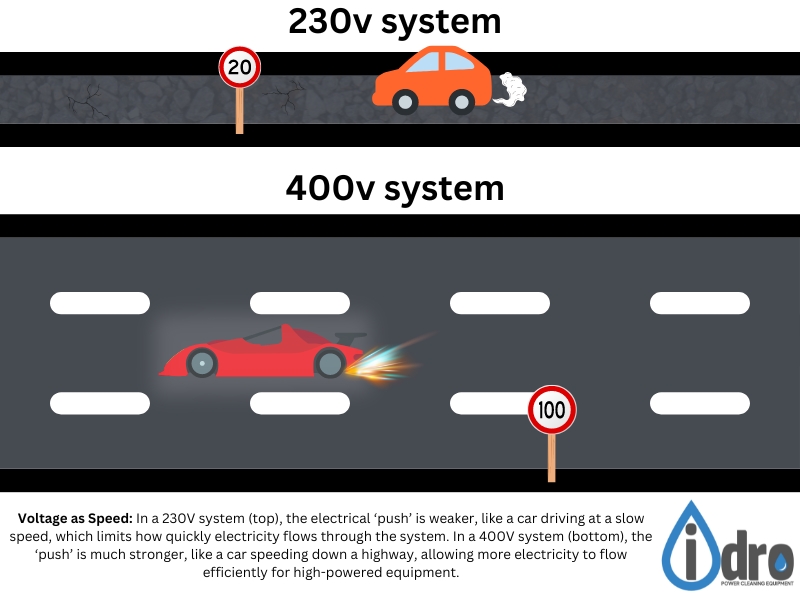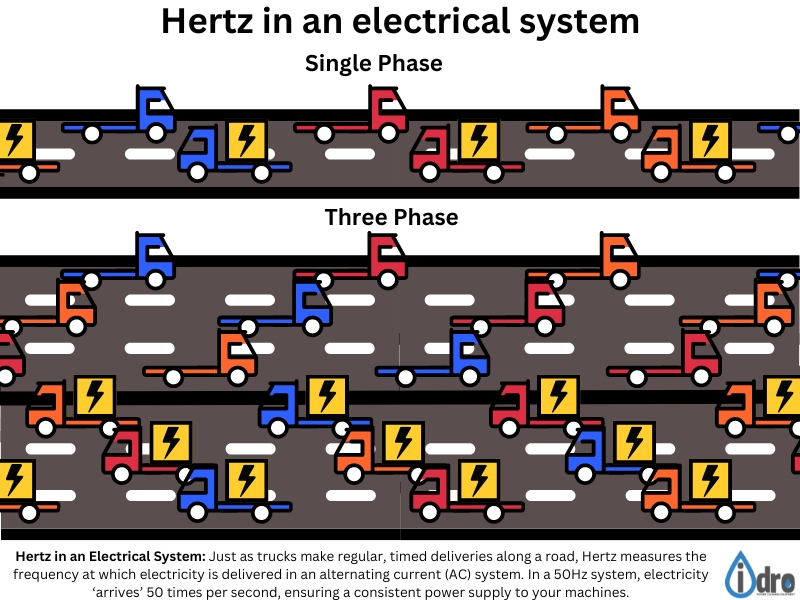Power Supply Explained: Phase, Voltage and Hertz
Electrical specifications like "1 / 230V / 50Hz" or "3 / 400-415V / 50Hz" might seem complex, but they reveal crucial details about how your equipment operates. These numbers refer to phase, voltage, and hertz—the building blocks of any power supply.
Understanding these elements ensures your machines run efficiently and prevents costly mistakes. Whether you're powering small appliances or large industrial equipment, choosing the right power setup is critical.
In this article, we’ll break down phase, voltage, and Hertz using a simple analogy: traffic on a road. Just as cars move at different speeds and frequencies, electricity flows in specific ways. By the end, you’ll have a clear understanding of how to match the right power supply to your equipment.
Electrical Phases
When you see electrical specifications like "1 / 230V / 50Hz" or "3 / 400-415V / 50Hz," the first number refers to the phase of the electrical system. "1" means the equipment runs on single-phase power, while "3" means it requires a three-phase power supply. But what exactly is the difference, and why does it matter?
What is Single-Phase Power?
In a single-phase system, electrical current flows through a single alternating current (AC) path. This setup is common in residential homes and smaller commercial spaces, as it efficiently powers everyday appliances.
Single-phase as a One-Lane Road
Imagine a single-phase system as a one-lane road. All the electricity moves along this one "lane," just like cars driving down a quiet residential street. This road can handle regular household traffic—things like lights, small kitchen appliances, or a vacuum cleaner—because the power demand is relatively low.
Limitations of Single-Phase for Heavy Equipment
While simple and sufficient for most household tasks, single-phase systems aren't ideal for heavy-duty equipment because the power delivered fluctuates, causing occasional peaks and drops. This makes it less suitable for machinery that requires a steady, constant power supply.

How Three-Phase Power Works?
A three-phase system distributes electricity through three alternating currents, each one staggered by 120 degrees. This stagger ensures that the power delivery is more constant and continuous, as the current from one phase reaches its peak while the others are still rising or falling. This coordinated, overlapping flow makes three-phase systems perfect for industrial or large commercial applications that need more consistent and higher power levels.
Three-Phase as a Three-Lane Motorway
Now think of a three-phase system as a three-lane motorway. Each lane represents a phase of electricity, and while the cars (or the electrical current) in each lane are moving at the same speed, they are spaced slightly apart from one another. This staggered timing allows for smooth, uninterrupted traffic flow, just like the continuous power delivery in a three-phase system. By spreading the load across three paths, the system can deliver more power without interruptions, reducing strain and increasing efficiency.
The Benefits of Continuous Flow for Heavy Equipment
For high-powered equipment—like large industrial machines or heavy-duty pressure washers—this constant, staggered flow is critical. It ensures that the power supply is smooth and uninterrupted, allowing equipment to operate efficiently without the fluctuations or power dips that can occur in single-phase systems.
Why Phase Matters
Choosing the right phase is crucial for your equipment’s performance. If your setup only supports single-phase power, it will be unable to handle machines designed for three-phase power without significant modifications. Similarly, using three-phase power for lightweight tasks may be unnecessary and inefficient.
Matching Power to Your Equipment
For example, if you have a single-phase power supply, a machine like the Kranzle K1152 would be a good fit, as it's designed for lower power needs. However, for heavier-duty machines like the Ehrle HD Series, which requires more stable and robust power, a three-phase supply is essential to ensure proper operation.
Voltage (V)
In the specifications “1 / 230V / 50Hz” or “3 / 400-415V / 50Hz,” the number followed by "V" (such as 230V or 400V) represents the voltage. But what does voltage actually mean?
Understanding Voltage as Electrical Force
Voltage is the measure of electrical potential difference, which can be thought of as the "force" or "speed" that drives electric current through wires. The higher the voltage, the faster and more forcefully electricity moves through the system.
Voltage as Speed in the Car Analogy
Imagine voltage as the speed of cars on a road. If the cars are moving slowly (low voltage), they might struggle to reach their destination in time to meet the demand. But if the cars are moving quickly (high voltage), they can get there faster and more efficiently. However, just as cars driving too fast on a narrow road can lead to accidents, using too much voltage can overload and damage electrical equipment.

Choosing the Right Voltage
The voltage specification of your machine tells you how fast the "traffic" (electricity) needs to flow. For example, a machine designed for 400V needs a faster flow of electricity to operate efficiently, much like a fast-moving car on a motorway. On the other hand, a 230V machine requires a slower, steadier flow, much like cars moving at residential speeds.
The Risks of Using the Wrong Voltage
Using the wrong voltage is like sending fast-moving cars (high voltage) down a narrow residential street—it's risky and can cause damage. Similarly, using low voltage for a machine that needs high voltage is like sending slow-moving cars on a motorway—it won't get the job done efficiently.
Voltage-Specific Products
- For 230V systems: Machines like the Ehrle KD623 pressure washer are ideal for use in residential or light commercial setups.
- For 400V systems: For more industrial applications, the Ehrle HSC1240 hot water pressure washer is designed to handle the higher voltage demands of heavy-duty equipment.
Hertz (Hz)
The final number in “1 / 230V / 50Hz” or “3 / 400-415V / 50Hz” represents Hertz (Hz), which measures the frequency of electrical current. In an alternating current (AC) system, electricity constantly changes direction, and Hertz tells us how many times this happens per second. For example, a power supply marked with “50Hz” means the current alternates direction 50 times every second.
Thinking of Hertz as Delivery Frequency
Think of Hertz as how often trucks make deliveries on a road. In a system running at 50Hz, a new truck loaded with electricity arrives 50 times every second, ensuring a regular and constant supply of power. Just like trucks arriving at regular intervals, the higher the Hertz, the more frequent the deliveries of electricity to your machines.

Why Hertz Matters
Hertz is crucial for maintaining a steady flow of power to your equipment. If the frequency is too low, it’s like having fewer trucks on the road, causing delays in deliveries and potentially underpowering your machines. If the frequency is too high, it might overload the system, leading to equipment malfunctions.
Global Hertz Standards
In most regions, such as Europe, electrical systems operate at 50Hz, meaning 50 deliveries (or cycles) of electricity are made per second. In places like North America, the standard is 60Hz. Using equipment designed for one frequency in a different system without adjustment can lead to issues. For example, a machine built for a 50Hz system used in a 60Hz environment might run faster than intended, while one designed for 60Hz may underperform in a 50Hz system.
Hertz-Specific Products:
- Standard 50Hz systems: Most of our machines, such as the Kranzle K1050 range pressure washer, are designed to work within the standard 50Hz frequency found in Europe (link to product).
- Higher performance needs: For heavier industrial tasks running on a 50Hz frequency, the Ehrle KD1340 cold water pressure washer provides reliable performance for larger commercial needs (link to product).
Making the Right Power Decisions
Understanding phase, voltage, and hertz is essential for ensuring that your equipment receives the right power supply. Like traffic on a road, electricity must flow smoothly, at the right speed, and with the proper frequency to keep machines running efficiently and safely.
Making Informed Equipment Choices
By knowing how single-phase and three-phase systems differ, why voltage matters for power capacity, and how Hertz ensures steady delivery, you can make informed decisions about the equipment you choose. Matching the correct power supply to your machines not only ensures optimal performance but also extends the life of your equipment.
The Impact of the Right Setup
Whether you're running a small 230V system or managing high-demand machines on 400V three-phase power, the right setup makes all the difference. If you need help selecting the best pressure washer or industrial machine for your needs, feel free to get in touch with our team.



